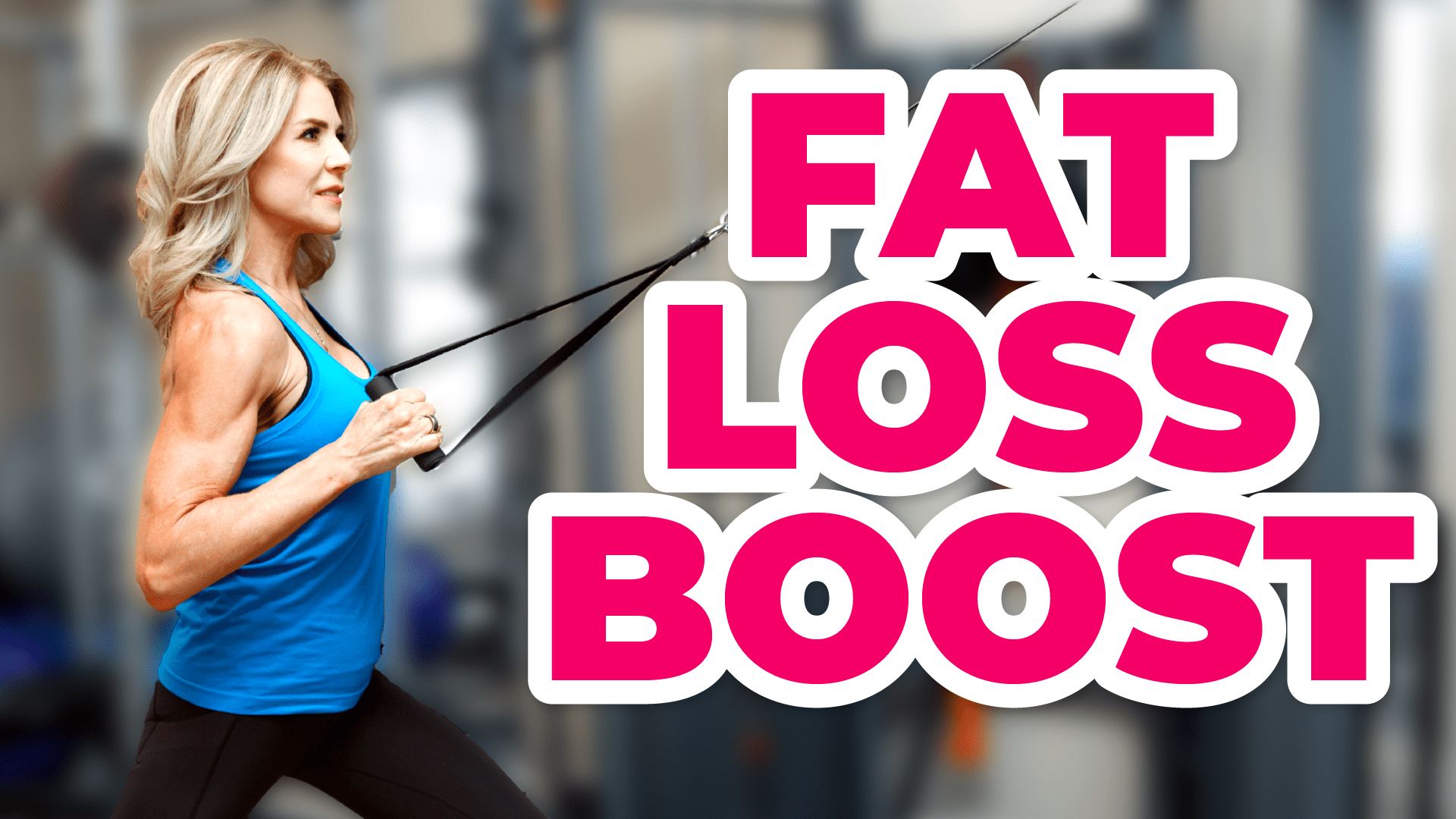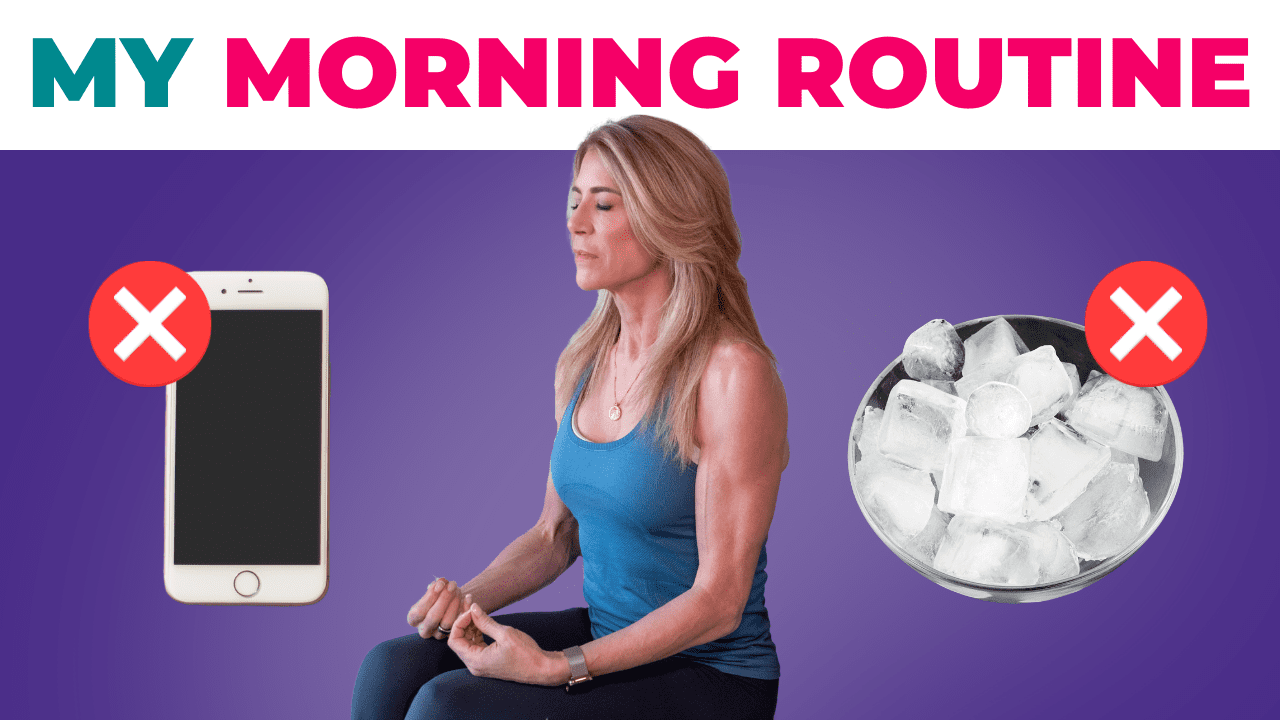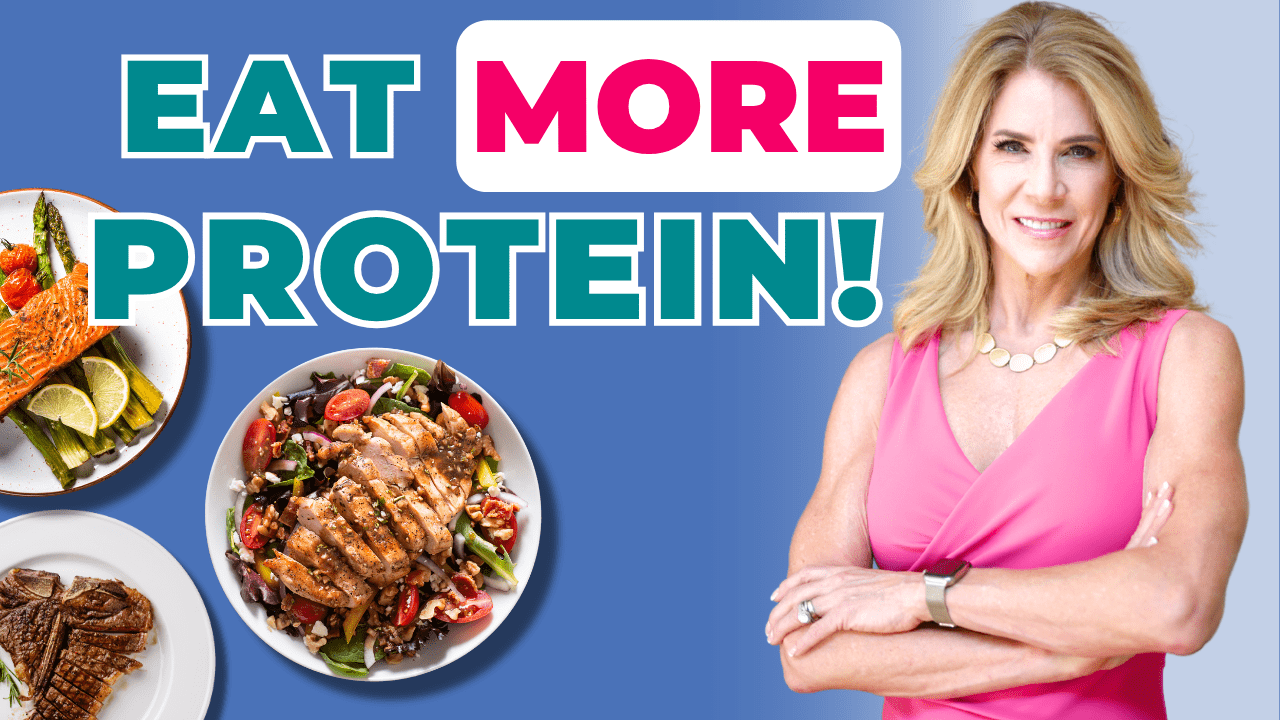Stop Focusing on Metabolism and Start Changing Your Body
Menopause can make you lose your butt and gain a gut… and believe it or not, your metabolism may not be to blame.
So if the problem isn’t metabolism, what is it? That’s what I’m explaining in this episode. Then, I’m sharing proven strategies to build muscle, reduce deep belly fat, enhance insulin sensitivity, and get hormonal weight gain under control—including seven exercises to get things moving in the right direction.
Give it a listen right now to start making fat-burning moves today!
Timestamps
00:01:00 – Don’t believe this myth about menopause and metabolism
00:02:37 – Why muscle quality is important during menopause
00:03:47 – Which type of exercise can help you lose belly fat?
00:05:20 – These power exercises can be your warmup or HIIT
00:07:41 – Do these functional exercises three times a week to build muscle
00:13:10 – A simple practice to help keep cortisol in check
Resources Mentioned in this episode
Watch the FULL VIDEO on my YouTube Channel
Read my book, Sugar Impact Diet
Use my Protein Calculator
Download my free Resistance Training Cheat Sheet
Reignite Wellness™ Protein First Enzymes
Watch How Much Protein Do You Really Need Over 40?
ATHE_Transcript_Ep 642_7 Simple Exercises to Boost Your Fat Loss After Menopause
[00:00:00] I’m J. J. Virgin, Ph. D. dropout. Sorry, Mom. Turned four-time New York Times bestselling author. Yes, I’m a certified nutrition specialist, fitness hall of famer, and I speak at health conferences and trainings around the globe. But I’m driven by my insatiable curiosity and love of science to keep asking questions, digging for answers, and sharing the information I uncover with as many people as I can. And that’s why I created the Well Beyond 40 podcast,
[00:00:30] to synthesize and simplify the science of health into actionable strategies to help you thrive. In each episode, we’ll talk about what’s working in the world of wellness, from personalized nutrition and healing your metabolism, to healthy aging and prescriptive fitness. Join me on the journey to better health, so you can love how you look and feel right now, and have the energy to play full out.
[00:01:00] Okay. Let’s bust a big myth. Your metabolism doesn’t actually hit the skids with menopause, but it feels like it does. So what’s up with that? My mother called it shifting sands, where you basically lose your butt and gain a gut. And I was determined not to have that happen to me or my clients, but to fix it, you first need to know what’s going on. If it’s not metabolism dropping off the cliff, what the heck is it?
[00:01:30] Now one of the things that happens as we age that puts,makes this all problematic and compounds the problem It’s something called anabolic resistance. And this means that as we age it gets harder for us to trigger Muscle Protein Synthesis. And we trigger muscle protein synthesis two ways. One is through diet, and specifically an amino acid called leucine. This was the work of Dr. Donald Lehman, where he found that leucine was this trigger to turn on mTOR,
[00:02:00] to turn on muscle protein synthesis, and also resistance training. So you need both of those to really build muscle and need to have them in optimal amounts. So with protein, it’s making sure you get .7-1 gram per pound of target body weight. I actually created a protein calculator to help you figure out how much you uniquely need. You can get that at jjvirgin.com/proteinfirst. And resistance training, when you think of exercise, I want you to think of things that are harder
[00:02:30] than what you’re used to. So your body has to adapt and get stronger. That’s called progressive overload. So one of the big goals for powerful aging is to improve the quality of your muscle. One of the things that happens as we age is our muscle starts to get infiltrated with fat and more insulin resistant. We want to improve the quality of the muscle. We want to go from being rib eyes to fillets. And what’s important and cool here is that when you improve the quality of the muscle, this is super
[00:03:00] important for menopause, because you’re going to improve insulin sensitivity. And by the way, think of muscles as your Metabolic Spanx. They hold everything in tighter. They support a better metabolism and your sugar sponge, where they give carbohydrates a place to go. They’ll go into your muscles so you can use them for energy the next time you train. And they improve your insulin sensitivity quickly, so that you don’t have to push as much insulin out in response to carbohydrates, in order to
[00:03:30] bring the carbohydrates back down to your blood sugar back down to a normal level. So muscle is super important for all of these things. Now. Along with that, resistance training can also help naturally raise testosterone. So that’s super important too. And high intensity interval training (HIIT) can help you lose that belly fat, that visceral adipose tissue. Now, again, when we think of losing belly fat, you probably think, “Oh, I need to do lots of cardio.”
[00:04:00] Actually. A caloric deficit is what’s going to help you lose overall fat. And then some of the things that can really help focus on losing visceral adipose tissue, exercise wise, high intensity interval training can make a big impact here. When you think about the right exercise it’s going to help your body improve insulin sensitivity. It’s going to help your body raise growth hormone. It’s going to help your body also handle cortisol better. Train your nervous system how to handle stress better. And high intensity interval training and resistance training do this very well
[00:04:30] because these are short, intense bursts that you recover from. So you do hard and then you recover. And finally, I have to do a mention to mindfulness and breath work because that too can help you with training your nervous system to handle stress better. and bringing that cortisol back down. So with that, I’m going to give you seven simple exercises that can help. Now, if you are listening to this on Beyond 40, instead of watching me on my JJ Virgin
[00:05:00] YouTube channel, you may just want to pop over and subscribe to the YouTube channel because I’ve been putting a lot of demos for exercise up there as well. And I am going to demo a little bit here, but I’ll talk you through it too. So either way, I got you covered. One of the first things I like to do, because I like to move in different planes, and so you can move front and back. You can move side to side and you can rotate. So one of the first things that I’m going to do is just a side to side. This is just called a skater and you can actually make this
[00:05:30] easier or harder. So right now, I’m doing this pretty simple by just going for my knees, but you can go all the way down to the floor and make it a harder, right? So that’s a skater. And if I was doing these as a warmup, I do, 30 to 60 seconds. And then I would take about the same amount break and do it again. Let me show you a squat ball throw. Now, medicine ball is a heavy weighted ball and these are great for power exercises
[00:06:00] because you can explode and throw or move them side to side. This one’s pretty simple. All I’m doing here is a squat and a throw. And when you do these, you want to go as fast as you can. The next one I’m going to show you is a woodchop. Now, what’s cool about this is a great way to get rotation in. And again, I’m using a heavy weighted ball and what you do is you want to think of this that your torso is all connected. Your arms are just slightly bent.
[00:06:30] The ball is down in front of your hips, to start with, like right in front of your crotch, basically. And you’re gonna rotate over and touch your thigh. So I’m touching my left thigh right now, and I’m gonna lift up over my right shoulder. But I’m trying to keep my arms and torso as if they’re one unit. When I’m doing this, and then I bend my knees a little bit as I go too. I am doing a little quad and glute, but a lot of this is happening through all of my rotational muscles
[00:07:00] through my spine and my upper torso. So those are three power exercises. Again, move through all three planes. You can use it as a warmup when you’re doing other types of exercises. You could do that as your own little HIIT training too, where you did hard for 30 to 60 seconds, recover for 30 to 60 seconds. And again, for high intensity interval training, there’s all sorts of different variations on it, but basically it’s hard and recover. It’s just whether you want to recover for twice as long,
[00:07:30] half as long, the same amount. Mix it up is my biggest advice there. Now, those really focused on power and we had some HIIT in there that can help with visceral adipose tissue. Now we’re going to talk about muscle hypertrophy. And muscle hypertrophy is really about volume and progressive overload. So, in order for your muscle to grow, you have to do more than what it’s used to, right? And you have to be consistent with it. If you do this once a month,
[00:08:00] nothing’s going to happen. Ideally, you’re doing this 2-3 times a week, and I would tell you, 3 times is probably better. And, you’re doing multiple sets. The range for hypertrophy, or building muscle, is anywhere from 6-30 repetitions of multiple sets. I find that working in the 8-15 range is probably easiest, taking about a minute or two break, doing multiple sets. And I like to do compound exercises because it’s going to require, it’s going to be a bigger metabolic cost to your body.
[00:08:30] And these are way more functional than say someone doing just a bicep curl, not something you normally do in life. Whereas a squat is something you do all the time. You’re getting out of a chair, you’re getting out of a car, right? A squat is a very functional movement. So, in order to do a squat, if you’re new to it, make sure that you have a mirror that you can look in. And ideally you have a chair behind you because what you can do is tap down on the chair and stand back up, right? And that’s an easy way to start. Another way you can do it is to cheat with a TRX machine
[00:09:00] to help hold you so that you can get your range of motion. And all I’m doing in the squat is coming down, tapping, and up. To, when I’m just starting doing an air squat, I like to keep my hands around my shoulders and then look up over my hands so that I’m keeping my chest and my head high and I’m really working on extending my spine and sitting back into my heels, as if I’m sitting down into a chair. So I’m really working on sitting back. And as I’m coming down, my knees are coming over my toes,
[00:09:30] and I’m keeping my chest extended, my back extended, so I can use my back extensor muscles. And this is an exercise that’s going to work primarily your quads and your glutes. But you also have to make sure you have a very strong core. If you notice, I talked squats, push ups, and bent over rows, and I didn’t do core, but you’ll see from each of these exercises that done correctly, they are pulling in your core. When I think core, I think of abdominals and back extensors, right? Both of them matter.
[00:10:00] Next up, I’m going to show you how to do a pushup. Okay. Here is the easiest way to do a pushup. I am hand and knee position. Now the important thing is that I’m bringing my chest down as low as I can and coming back up, but I’ve got most of my weight back so that I don’t have as much weight over my chest and shoulders. Now to make it harder, all I do is walk my feet, my legs back. And now I’ve got a lot more weight over my upper body. And now I’m going to come down as low as I can. I’m really trying to get to a point where I’m tapping my nose down.
[00:10:30] But important thing here is that I’m still pulling in my core. So I’m still doing a plank style position. So that is a harder position for a pushup. Next step is going up onto my toes. Now again, first thing here is to assume the plank position. So that’s the most important thing. Don’t sag through your hips. Hips are up, belly buttons pulled in, and we are coming down to basically a chest and nose tap.
[00:11:00] And that’s what’s important because I see a lot of people doing pushups and they’re doing these little movements. You got to come down through full range of motion. What’s fun about resistance training is it can improve your range of motion when you’re doing things through a full range of motion. It’s really important to do that. Next up is another super functional exercise which is a bent over row. I really love this as a way to strengthen your back because it’s so functional. And so many things in life involve us picking things up.
[00:11:30] So basically the way I have people do this is start and feel like you are just resting your hands on your knees, lifting your tailbone up, pulling your belly button up so that your spine is really extended. And you can use your back muscles to hold you in place.
So I’ve now pulled my belly button in tight to my spine. My quads are tight. And if someone came along and did this, I feel like I fell forward. So I’m really leaning. Then I pull my hands off my thighs and I pull my palms up towards my chest
[00:12:00] and then bring my back down. So, my palms face my knees. So, I’m rotating my hands as I lift them up. And as I’m doing this is an upper body pulling exercise that also has my core involved, but I’m using my lats. I’m using the back of my shoulders and my biceps up and down. I did an entire resistance training handout on this, which is fantastic. It is my free resistance training cheat sheet, all the home gym essentials that you might need,
[00:12:30] and an eight week beginner resistance training routine, and you can get that free at JJVirgin.com/power. Now there’s one more thing here when we really look at how to get our hormones in line so that we can avoid the hormonal weight gain that can happen as we age. So, I gave you the power moves, the HIIT moves that can help with the visceral adipose tissue.
[00:13:00] I gave you the resistance training that can help with testosterone and help with insulin sensitivity and help offset that muscle loss we have with aging. And then finally, that cortisol issue that I was talking about, one of the great things that can help there is breath work. Now the breath work I’m going to show you, you can also do this, like you could do some flexibility work. You could use this if you’re doing some holding some yoga poses and it is called box breathing.
[00:13:30] It is super duper simple. Basically, all you’re going to do is inhale through your nose for four. So we’re going to inhale one, two, three, four through your nose. Then you’re going to hold it for four. 3, 2, 1. Then you’re going to exhale 4, 3, 2, 1. Then you’re going to hold it. Those are some simple things that you can put into place that you can see you can do at home. So no excuses.
[00:14:00] However, I mentioned this before that if you want to lose fat, you’re going to also look at what’s at the end of your fork, because this can be your biggest ally in your fat loss journey. And you’re going to want to eat protein first. Now I explain this all in the next video, where I talk about how much protein you really need to build muscle, burn fat, and hit your body composition goals over 40.
[00:14:24] Be sure to join me next time for more tools, tips, and techniques you can incorporate into everyday life to ensure you look and feel great. And more importantly, that you’re built to last. And check me out on Instagram, Facebook, YouTube, and my website, jjvirgin.com. And make sure to follow my podcast so you don’t miss a single episode at subscribetojj.com. See you next time.
[00:14:57] Hey, JJ here, and just a reminder that the Well Beyond 40 Podcast offers health, wellness, fitness, and nutritional information that’s designed for educational and entertainment purposes only. You should not rely on this information as a substitute for, nor does it replace, professional medical advice, diagnosis, or treatment. If you have any concerns or questions about your health. You should always consult with a physician or other health care professional. Make sure that you do not disregard, avoid, or delay obtaining medical or health-related advice from your healthcare professional because of something you may have heard on this show or read in our show notes. The use of any information provided on this show is solely at your own risk.
Hide Transcript

 Subscribe to our show
Subscribe to our show 





